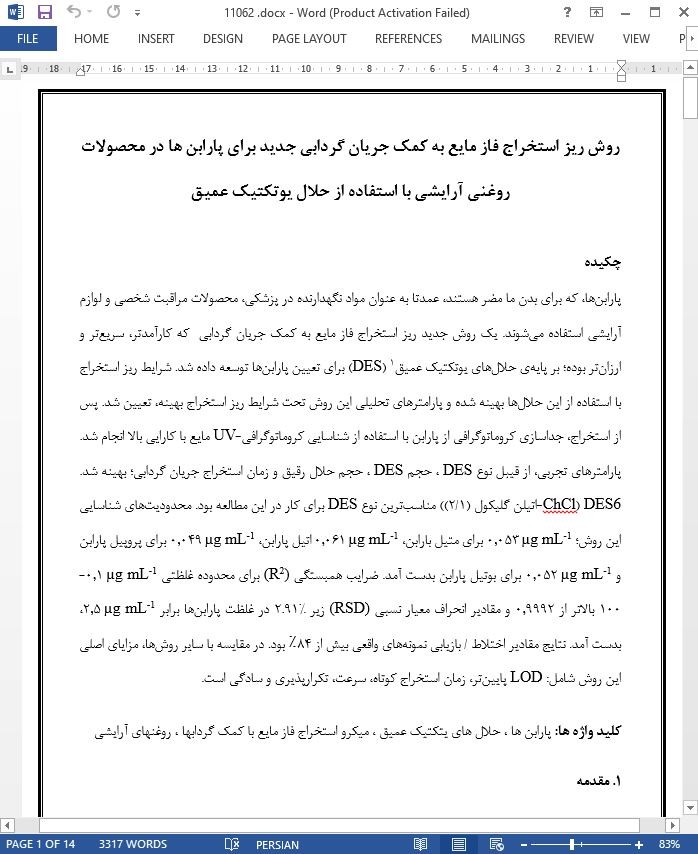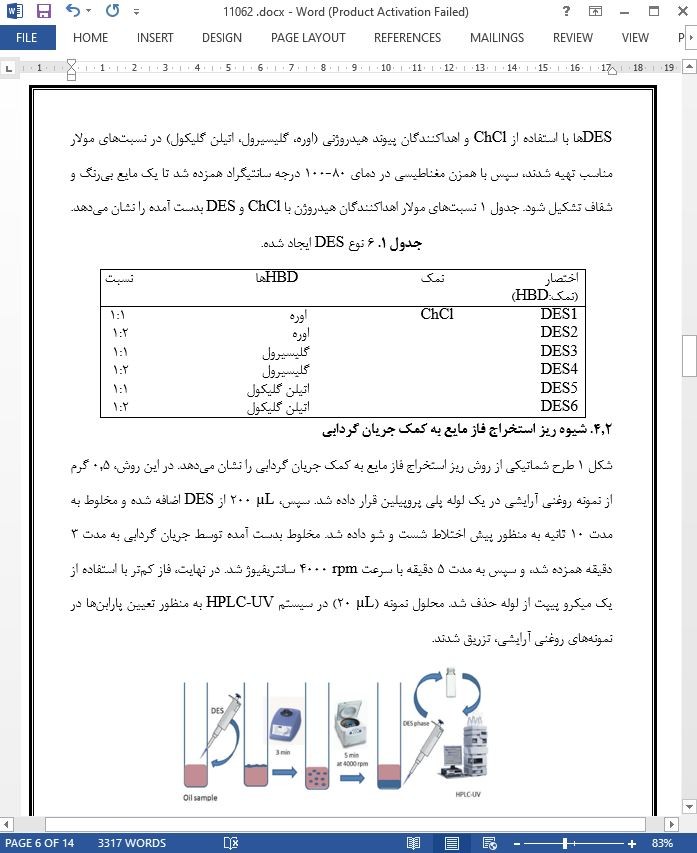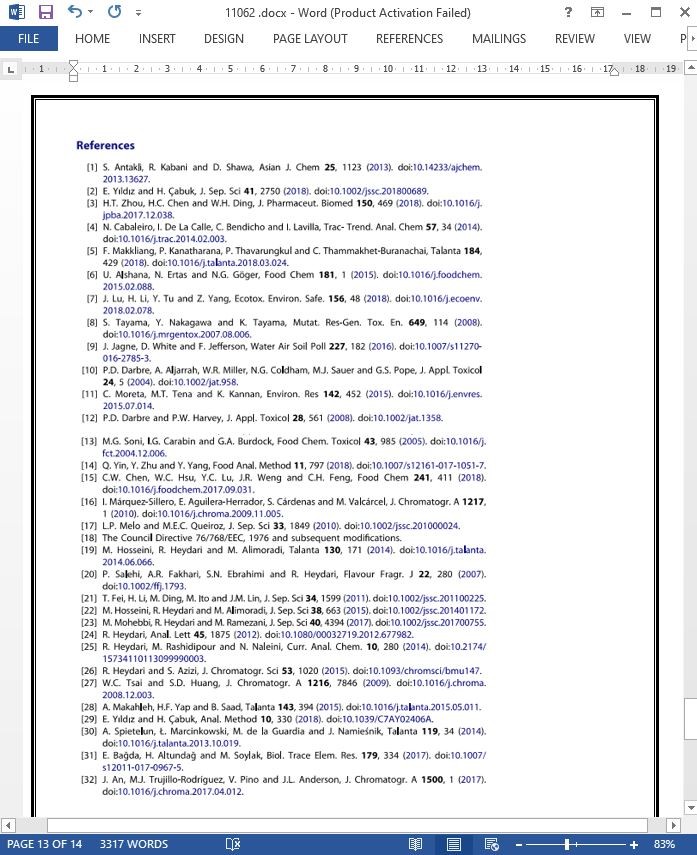
روش ریز استخراج فاز مایع به کمک جریان گردابی جدید برای پارابن ها در محصولات روغنی آرایشی
چکیده
پارابن ها، که برای بدن ما مضر هستند، عمدتا به عنوان مواد نگهدارنده در پزشکی، محصولات مراقبت شخصی و لوازم آرایشی استفاده می شوند. یک روش جدید ریز استخراج فاز مایع به کمک جریان گردابی که کارآمدتر، سریع تر و ارزان تر بوده؛ بر پایه ی حلال های یوتکتیک عمیق (DES) برای تعیین پارابن ها توسعه داده شد. شرایط ریز استخراج با استفاده از این حلال ها بهینه شده و پارامترهای تحلیلی این روش تحت شرایط ریز استخراج بهینه، تعیین شد. پس از استخراج، جداسازی کروماتوگرافی از پارابن با استفاده از شناسایی کروماتوگرافی-UV مایع با کارایی بالا انجام شد. پارامترهای تجربی، از قیبل نوع DES ، حجم DES ، حجم حلال رقیق و زمان استخراج جریان گردابی؛ بهینه شد. DES6 (ChCl-اتیلن گلیکول (1/2)) مناسب ترین نوع DES برای کار در این مطالعه بود. محدودیت های شناسایی این روش؛ µg mL-1 0.053 برای متیل بارابن، µg mL-1 0.061 اتیل پارابن، µg mL-1 0.049 برای پروپیل پارابن و µg mL-1 0.052 برای بوتیل پارابن بدست آمد. ضرایب همبستگی (R2) برای محدوده غلظتی µg mL-1 0.1-100 بالاتر از 0.9992 و مقادیر انحراف معیار نسبی (RSD) زیر 2.91% در غلظت پارابن ها برابر µg mL-1 2.5، بدست آمد. نتایج مقادیر اختلاط / بازیابی نمونه های واقعی بیش از 84٪ بود. در مقایسه با سایر روش ها، مزایای اصلی این روش شامل: LOD پایین تر، زمان استخراج کوتاه، سرعت، تکرارپذیری و سادگی است.
1. مقدمه
به منظور جلوگیری از زوال و فساد، بسیاری از مواد نگهدارنده و افزودنی ها به طور گسترده ای در مواد غذایی، دارویی و محصولات آرایشی استفاده می شوند و به این ترتیب زمان ماندگاری را افزایش می دهند [1،2]. مصرف-کنندگان از طریق بلعیدن غذاهای فرآوری شده و محصولات دارویی، یا استفاده از محصولات مراقبت شخصی و لوازم آرایشی در معرض بسیاری از مواد شیمیایی قرار می گیرند. با این حال، تمایل به تحریک آلرژیک این نگهدارنده ها ممکن است برای مصرف کنندگان مضر باشد ]3-5[.
4. نتیجه گیری
6 DES همراه با کلرید کولین HBDها به منظور استخراج پارابن ها از روغن های آرایشی متفاوت، تهیه شدند. تعیین شد که DES6، از کلرید کولین و اتیلن گلیکول تشکیل شده، موثرترین نمونه برای استخراج پارابن ها از روغن های آرایشی بود. DES6 سنتز و مشخصه یابی شد، و سپس طی ریز استخراج فاز مایع به کمک جریان گردابی پارابن ها از نمونه های روغنی آرایشی بکار رفت. استخراج پارابن ها با DES قبل از این مطالعه نشده بود. روش توسعه یافته برای استخراج و شناسایی پارابن ها در روغن های آرایشی ساده بوده و سازگار با محیط زیست است. مزیت دیگر این روش سرعت بالاست، که به زمان استخراج در حدود 3 دقیقه نیاز دارد، که از هیچ حلال آلی (هگزان) استفاده نمی کند و LOD آن در مقایسه با دیگر روش ها بسیار کم است. نتایج نشان می دهد که DES6 می تواند به صورت کمی پارابن ها را از روغن های آرایشی استخراج کنند، هنگامی که با روش ریز استخراج فاز مایع به کمک جریان گردابی (V-LPME) ترکیب می شود. مورفولوژی با استفاده از آزمایش های اختلاط/بازیابی با مقادیر بیشتر از 84٪ برای متیل، اتیل، پروپیل و بوتیل پارابن تصدیق شد.
ABSTRACT
The parabens, which are harmful to our bodies, are primarily utilized as preservatives in medicine, personal care products and cosmetics. A novel, more efficient, fast and cheap vortex-assisted liquid phase microextraction method based on deep eutectic solvents (DESs) was developed for the determination of parabens. The microextraction conditions were optimized using these solvents and the analytical parameters of the method were determined under optimal microex traction conditions. After extraction, the chromatographic separation of parabens was undertaken using high-performance liquid chroma tography-UV detection. Experimental parameters, such as DES type, DES volume, dilution solvent volume and vortex extraction time were optimized DES6 [Cha-Ethylene glycol (112)] was the most suitable DES to work In this study. Detection limits for this method of 0.053 µg ml_, for methylparaben, 0.061 µg ml_, for ethylparaben, 0.049 µg ml-1 for propylparaben and 0.052 µ9 ml-1 for butylpar aben were obtained. Correlation coefficients (R") for a concentration ranged 0.1-100 µg ml_, were higher than 0.9992 and relative standard deviation (RSD) values below 2.91% at parabens concentra tion of 2.5 µg ml-1 were obtained. The results of spike/recovery values of real samples were greater than 84%. When compared with other methods, the main advantages include lower LOO, short extraction time, rapidity, repeatability and simplicity.
1. Introduction
In order to prevent aging and deterioration, many preservatives and additives are widely utilized in food, medicine and cosmetic products and thus extend shelf life [1,2]. Consumers are exposed to many chemicals through the ingestion of processed food and pharmaceu tical products, or the application of personal care products and cosmetics. However, the tendency to allergic stimulation of these protectors may be harmful to consumers [3-5].
4. Conclusion
Six DESs were prepared with choline chloride and HBDs for the extraction of parabens from different cosmetic oils. It was determined that DES6, formed from choline chloride and ethylene glycol was the most effective for the extraction of parabens from cosmetic oils. The DES6 was synthesized and characterized, and then applied during the vortex assisted liquid-phase microextraction of parabens from different cosmetic oil samples. The extraction of parabens with DES has never been studied before. The developed method for the extraction and detection of parabens in cosmetic oils is simple and environmentally friendly. The other advantages of this method are that it is very rapid, with an extraction time of as little as 3 minutes being required, it uses no organic solvents (hexane) and the LOD is very low compared with other methods. The results show that DES6 can quantitatively extract parabens from cosmetic oils when combined with vortex-assisted liquid phase microextraction (V-LPME). The methodology was vali dated using spike/recovery experiments with values greater than 84% for methyl, ethyl, propyl and butyl parabens being achieved.
چکیده
1. مقدمه
2. کار تجربی
1.2. واکنش دهنده ها و محلول ها
2.2. تجهیزات
3.2. تهیه DES
4.2. شیوه ریز استخراج فاز مایع به کمک جریان گردابی
5.2. استراتژی بهینه سازی
3. نتایج و بحث
1.3. مشخصه یابی DES
2.3. اثر انواع DES
3.3. اثر حجم DES
4.3. اثر حجم حلال رقیق
5.3. اثر زمان جریان گردابی
6.3. عملکرد تحلیلی
7.3. کاربرد روش توسعه یافته برای نمونه های واقعی
8.3. مقایسه با دیگر روش ها
4. نتیجه گیری
ABSTRACT
1. Introduction
2. Experimental
2.1. Reagents and solutions
2.2. Instrumentation
2.3. Preparation of DES
2.3. Vortex-assisted liquid phase microextraction procedure
2.4. Vortex-assisted liquid phase microextraction procedure
2.5. Optimization strategy
3. Results and discussion
3.1. Characterization of DES
3.2. Effect of DES types
3.3. Effect of DES volume
3.4. Effect of dilution solvent volume
3.5. Effect of vortex time
3.6. Analytical performance
3.7. The application ol developed method to real samples
3.8. Comparison with other methods
4. Conclusion
- اصل مقاله انگلیسی با فرمت ورد (word) با قابلیت ویرایش
- ترجمه فارسی مقاله با فرمت ورد (word) با قابلیت ویرایش، بدون آرم سایت ای ترجمه
- ترجمه فارسی مقاله با فرمت pdf، بدون آرم سایت ای ترجمه



